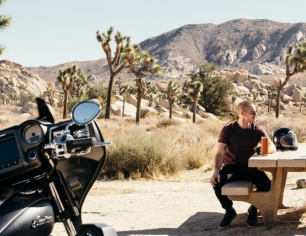What are the differences between mopeds and scooters?
Mopeds and scooters are similar vehicles, but there are distinct differences between them in terms of top speed, engine size, and chassis design. As a result, insurance requirements for each differ, too. Some small-engine mopeds may not require insurance, but almost every scooter will need some form of coverage.
Explore Progressive's editorial standards for Answers articles to find out why you can trust the insurance information you find here.
What is a moped?
Mopeds, originally considered motorized bicycles, are compact, slower vehicles that typically get better gas mileage than scooters. While their low speeds make them appealing to commuters in cities, mopeds aren't allowed on major highways because of their engine size.
With a maximum engine size of 50 cubic centimeters, a moped's speed typically only reaches 28 to 30 miles per hour. Laws regarding moped licenses vary widely from state to state – some require an endorsement or a license to operate a moped on the road, while several states don't require having any special license at all.
What is a scooter?
Scooters are similar to mopeds in many ways but typically have larger engines that range in size from 50cc to 250cc. That means higher top speeds, as high as 60 or 70 miles per hour. Like mopeds, scooters tend to be extraordinarily fuel-efficient, though those with larger engines are typically less fuel-efficient than those with smaller engines.
How fast can a scooter go?
Some scooters can go as fast as, if not faster than, motorcycles. The main difference between a scooter and a motorcycle is found in the frame and design of the vehicle. However, most states don't differentiate between the two legally. To operate a road-legal scooter, most states require a driver to have a motorcycle license. That also means scooters are often insured as motorcycles. Learn more about how motorcycle insurance works.
Is insurance required for mopeds and scooters?
You're generally required to have liability insurance if operating any vehicle with an engine of 50cc or greater, though requirements vary by state. Liability insurance protects against damages or injuries you cause while operating the vehicle. In addition, some lenders may require physical damage coverage if you finance the vehicle.
Some states require liability insurance for any motorized vehicle on the road, while others don't require insurance if the engine is smaller than 50cc or the top speed is lower than 30 miles per hour.
How much insurance is required for mopeds vs. scooters?
Although requirements vary, riders must typically have as much bodily injury and property damage liability coverage while driving a scooter or moped as they would when operating a motorcycle. For example, a state may require a minimum of $25,000 in bodily injury per person, $50,000 in bodily injury per accident, and $25,000 of property damage per accident. Riders can choose to carry higher amounts of liability insurance. Higher coverage limits mean higher premiums, but it also means more protection if you cause an accident.
In addition to liability, moped and scooter riders might choose to carry comprehensive and collision insurance coverages. Comprehensive coverage protects the scooter or moped against events outside of your control, such as theft, vandalism, or storm damage. Collision coverage can help pay the repair or replacement cost of your moped or scooter if it gets damaged in an accident with another person.
You might also choose to have carried contents and belongings coverage. This type of coverage protects any personal belongings on the scooter or moped, such as your phone, in the event of a covered loss while riding.
Looking to insure your scooter or moped? Get a scooter or moped insurance quote online or call 1-855-347-3939.
What are the differences in moped and scooter laws?
Different states view the legal classifications of mopeds and scooters differently. For instance, some states consider a moped to be any vehicle with an engine size of 50 cc or less. In some states anyone 15 years old or older can operate a moped as long as they have a learner's permit. Headgear and tags may or may not be required. And in some states mopeds can't be operated on a road that exceeds a certain speed limit.
Some states define a scooter as any vehicle with an engine greater than 50cc and less than 350cc. In many states a scooter must be registered, which means it must have a tag, and it must be street legal. Because states vary in their approach, it's important to check your local regulations regarding the scooter and moped laws in your area.

Enjoy life on two wheels with motorcycle insurance from Progressive
Learn more about our motorcycle insurance offering.









